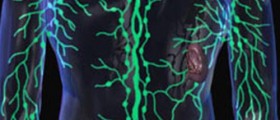Lymphatic system is an integral part of the immune system, responsible for the maintenance of good health. It consists of lymph nodes, and these nodes contain white blood cells, which filter every foreign particle that enters the body.
Swelling of the lymph nodes can affect any part of the body since they are widely distributed in the human organism. Most commonly, though, people experience swelling of the lymph nodes in the neck (called cervical lymph nodes), under arms (armpits), or in the genital area.

Symptoms of the Swelling of Lymph Nodes
Symptoms may include different problems, depending on the exact location of the swollen area in the neck. People can feel swelling on the upper part of the neck, under their chin, or around their ears.
This problem may but doesn’t have to be necessarily associated with pain, and in some cases, skin over the affected lymph node could get red and inflamed. Upper respiratory infection signs can accompany swollen lymph nodes as well.
If the person experiences rapid growth of the lymph node in the neck, its hardening and firming, might be a sign of a tumor. A lump in the neck can also be a symptom of the metastasis of tonsil cancer.
What Causes Swelling of the Neck Lymph Nodes
Infections of the upper part of the respiratory tract are known to trigger the swelling of the lymph nodes located in the neck. Common colds, sore or strep throat, and tonsillitis are some of the common problems associated with swollen lymph nodes. But tuberculosis and various bacterial and viral infections can also lead to the same problem.
There are also some other potential causes of the swelling, like infections of the teeth, sinuses, skin, or the ear, impetigo, gum-related problems, or even acne in some cases. Inflammation of the epiglottis (epiglottitis), peritonsillar abscess, rubella, or toxoplasmosis can also be possible causes of the swollen neck lymph nodes.
Swelling of the neck lymph node may be a sign of a serious medical condition, including sexually transmitted diseases (STDs) or cancers. Syphilis, leukemia, lymphoma, Hodgkin’s disease, and cancers of the mouth or larynx are known to lead to the swelling of the lymph nodes in the neck area.
- Children more commonly appear to have benign causes of lymphadenopathy. To better understand this, a study completed by Knight PJ et al. reviewed 239 children who underwent a peripheral node biopsy and found that the most common etiology noted was reactive hyperplasia of unknown etiology, followed by granulomatous infections, cancer, and dermatopathic lymphadenopathy.
- Adults also appear to have a low prevalence of malignancy. To further characterize this, a study was completed in a family practice setting where only 3% of 249 patients with lymphadenopathy underwent biopsies. Of these patients, no one was found to have a debilitating illness.
- A Dutch study also revealed that of 2556 patients that presented with unclear lymphadenopathy to their family physicians, 10% were referred for a biopsy, and only 1.1% were found to be related to malignancy.
- These findings are mirrored by two case series completed in family practice departments within the United States that demonstrated that 0 of 80 patients and 3 of 238 patients had malignant causes of lymphadenopathy, respectively.
- Generally, lymph node enlargement in younger populations (for example, children) tends to be benign and usually related to infection. There are exceptions to the rule, particularly if the patient’s history and physical are concerning for chronic infection, malignancy, or autoimmune conditions. Other risk factors that may be poor prognostic indicators include but are not limited to advanced age, length of duration of lymphadenopathy (> 4 weeks is concerning), generalized lymphadenopathy, male sex, lack of resolution of node size, and systemic signs (such as fever, night sweats, weight loss, hepatosplenomegaly).
- While lymphadenopathy itself may not lend itself to complications, unaddressed lymphadenopathy may lead to worsening progression of an underlying condition, the most concerning of which is sepsis or metastatic cancer. For lymphadenopathy related to autoimmune disorders, progressive autoimmune disease may lead to cancer or dysfunctional immunity, which may lead to significant morbidity and mortality.
What’s the Treatment
According to the cause of the problem, treatments may vary. Bacterial infections are resolved with antibiotic drugs, if necessary. If your doctor is suspecting some form of cancer as the cause of swollen lymph nodes in the neck, you should be diagnosed and then treated properly.
Once the cause is eliminated, the swelling should subside. If it doesn’t, you must consult your doctor and discover the reason for further problems.

















Your thoughts on this
Loading...